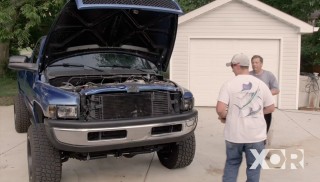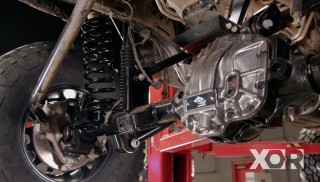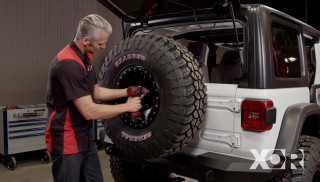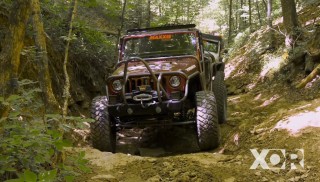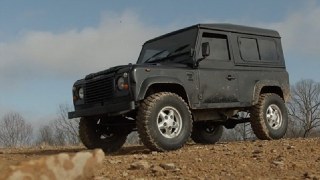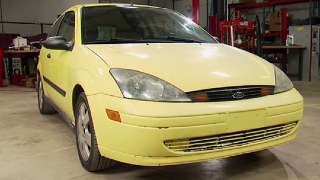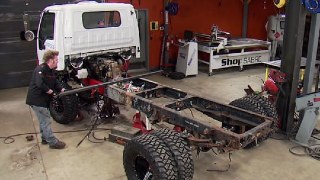XOR - Xtreme Off-Road Builds
Want more content like this?
Join the PowerNation Email NewsletterParts Used In This Episode
Lincoln Electric
Lincoln Electric is the official welding supplier to XOR
Matco Tools
MATCO Tools are the Official Tool Supplier to XOR
The Industrial Depot
Tools, Hardware, and Shop Supplies
Episode Transcript
(Narrator)>> Today on XOR our JL gets one heck of an axle, and we ditch the plastic for a custom bumper. Plus we'll get more stuff with some new fenders right now on XOR. ♪ ♪
(Eliza)>> The number one question I get asked when out trailing is what axles and what gears are you running? It's almost the mandatory question to ask when you're trying to make trail buddies. Now there's a vast variety of axle housing and differential manufacturers that we can outfit this JL well with, but none carry the same prestige and history as Dana does. We all know the Dana 60 and the work horse that that one ton axle is, but you may not know the benefits and features of Dana 30, 35, 44, and the ultimate Dana 44 Advantek. We're gonna gear down and check out what makes these axles awesome. Interestingly enough some of the early JK Dana 30's and 44's shared the same axle housing. Both of them coming in at two point six in diameter. However Dana upgraded their 44 for the JL and now it measures two point seven-six as you can see here. Both 44's share the same axle housing diameter but what makes the ultimate Dana 44 different is that the inner tube wall is thicker, making it harder to bend or distort. Now if you take a look at the "C's" they are both thicker and wider than the one that came out of our JL, and last but not least is our brackets are all made of quarter inch steel, making them very unlikely to bend. Let's talk ring gears. This is one we pulled off of our Dana 30. Now it does excellent on the highway and off road but it's not made to withstand off road abuse like our Dana 44. Now this will hold up to bigger size tires and a little bit more off road abuse, but it's not made for it like the UD 44. A special engineer team took the Dana 44 and really looked at how off road use breaks down the gear set. So they added more material to the teeth of the ring gear and allowed for a more efficient angle of the pinion to reduce cycle wear. They also changed the traditional taper bearing to a ball bearing for less resistance and longevity, and well, the difference between pinions just speaks for itself. This is our Dana 44 and this is our Dana 44 Advantek. Obviously you can see that it's gonna withstand quite a bit more cycles than the rest. And last but not least let's talk axle shafts. Now by design they are the weakest link of the assembly, and that's because you don't want to be changing out a full assembly out on the trail. Now Dana has upped their standards and made their axle shafts of nickel chro-moly, and they've included 30 splines. So it should hold up to most of your off road needs. I'll start assembly by inserting axle shafts and getting our aluminum knuckle in place. We'll secure all that in place with the hub. Next I'll tighten up our castle nuts and get them ready for the cotter pins. ♪ ♪ With those snugged up I'll trim them up a bit and move the UD 44 in place. ♪ ♪ And now it's time to get our UD 44 hung up under our JL. ♪ ♪ [ drill spinning ] ♪ ♪
(Eliza)>> Well our UD 44 is sitting pretty under the JL and all I need to do is finish up our steering and we are one step closer to hitting the trail.
(Jeremy)>> A lot of you guys out there want to run e-g-t sensors in your cast iron manifolds, and let's face it, they can be a real bear to drill through. Well we have Chris with Matco Tools and he's got a solution.
(Chris)>> Exactly, what we have here are the Matco Hyper Step Drill Bits. They're like a traditional twist drill bit but on the end it's a stepped design. It's kind of like a step drill. It makes drilling through cast iron manifolds such as this much easier. ♪ ♪ [ drill spinning ]
(Jeremy)>> Holy cow, that was impressive. Let's see what else these things can do. ♪ ♪ Alright try this.
(Chris)>> Okay. [ drill spinning ] ♪ ♪
(Jeremy)>> Man you can use these to drill through pretty much anything.
(Chris)>> That's right and you can find them exclusively through your Matco distributor.
(Jeremy)>> Cool, you're gonna leave these here right?
(Chris)>> I think we can work something out.
(Jeremy)>> Alright I'll just take these.
(Narrator)>> Up next Jeremy and Eliza ditch the stock bumper for something more to their liking on XOR.
(Eliza)>> One of the first impressions you get off a monster build is the front bumper, and we want ours to make a lasting impression. We've got the tools, we've got the stock, and we've got the time to make an awesome front bumper.
(Jeremy)>> We're gonna be integrating our winch into our bumper design, and we're gonna set it really low in between the frame rails because we want to show off our iconic Jeep grille, and the first thing we've got to do is get rid of this one and then we're gonna move on to some cardboard.
(Eliza)>> Ready?
(Jeremy)>> Let's do it. ♪ ♪ Cardboard can be your best friend when it comes to fabricating. Now we want our winch down low in between the frame rails. So I'm gonna go ahead, make some marks, and we'll cut the center of the cardboard out. We'll mark 12 on this side and we'll go down here and mark 13 with a little bit of angle. We'll use a straight edge to connect those marks, and we'll bring the whole piece over to our cutting table. ♪ ♪ Now this is where it turns into a puzzle. I'm gonna make this easier to build. So I'm gonna do it in four separate pieces. One, two, three, and four. Then I'm gonna transfer that onto the steel, use the plasma cutter to cut some pieces out, and then we'll use the Iron Worker to cut the other pieces out. ♪ ♪ Numbering the pieces keeps everything organized. Using a straight edge as our fence, we'll make the first long, straight cut. [ plasma cutter hissing ]
(Jeremy)>> And then free hand the small pieces because we'll trim them on the Iron Worker. ♪ ♪ [ mechanical humming ]
(Jeremy)>> And there's a lot of trimming, but the Iron Worker sure makes a nice, clean line. Then we'll punch some holes to bolt them on the frame. ♪ ♪ Now we're building our bumper out of eighth inch plate steel. I went ahead and made some backing plates for the pieces that are gonna bolt directly to the chassis cause this is gonna be a winch bumper and we're probably gonna end up pulling on this thing. So now all I've got to do is bolt these on, make sure they're nice and straight, and we'll get on to building this thing. ♪ ♪ Now we're gonna use our level as a straight edge to make sure these guys are perfectly straight. Then we'll just tighten them down. We'll fire up the welder and add this bottom piece so we have an additional mounting point to help support our bumper. And here's three more pieces to the side of the bumper. Five, six, and seven. We'll just go transfer these onto some steel and get them cut out. And now it's time to count. Five, ah, ha, ha! Six, ah, ha, ha, and Seven, ha, ha, ha! ♪ ♪ And now we'll just tack it all together. ♪ ♪ [ welder crackling ] ♪ ♪
(Jeremy)>> And the last piece of our bumper build is a piece we're not building at all. This is a winch plate we picked up from Summit Racing dot com. Not only will it give us a spot to mount our winch, it's gonna make our bumper a whole lot stronger. [ welder crackling ] ♪ ♪
(Jeremy)>> Well the bumper's all tacked up, winch is in place, and you can still see the grill, and I've got some more things to do. So why don't you guys go take a little break. ♪ ♪
(Eliza)>> You always want to have good recovery gear and a good trail buddy with his own rig before you hit the trails. Now you never want to hit the trails alone or in one vehicle because things can go awry really quickly. Now we've covered a lot of the things that you want to have out with you before you trail but we really haven't gone into depth about winches and best practices when you're rigging. Now first and foremost you want to think about personal safety. So a good pair of safety glasses and sturdy leather gloves because synthetic rope can have debris, and cable can fray, and that can lacerate your hands. Along with your winch you want to have the proper accessories, and that would include recovery points on your vehicle, which either attach to your bumper or to the frame, a good hook that's in good working condition, clevises or D-rings, a snatch block, and all of that is for a attachment, anchoring, and good recovery of your vehicle. Okay so I've shown you the accessories that you need to attach and anchor, but now I'm gonna show you the accessories that you need for an active recovery, and that is going to be a heavy blanket like this welding blanket here, a mover's blanket, or a recovery dampener. You will also need a tree saving strap, and if you're in the desert you will need a shovel and your spare tire. And last but not least you want to make sure that you've got some good jumper cables. Winches draw an incredible amount of amperage from your battery, even if you've got a good charging system. So having some of these ready is always a good idea. Now we've talked about the accessories that we need but let's see them in action. We talked about our recovery points. Now we want them to be tied into the frame. Our bumper is attached directly to the frame. So therefore we can have our recovery points mounted right on to the bumper. Now our D-ring loops through our recovery point so that somebody can come in, hook up, and pull us out of a pickle. Alright let's use our imagination. You're high centered and right across from you is a big, thick, rooted yellow tree. Disengage your gears, pull your rope or cable out, get your tree saver strap, wrap it around your tree, get your D-ring. Make sure that both strap ins are latched in well. Get your recovery hook and attach it to your D-ring, and make sure that everything is tight. Get your dampener. Put it in the middle of your strap. Get to position and start recovery. ♪ ♪ Be on the lookout for recovery tips.
(Narrator)>> Coming up Jeremy takes a trip down memory lane where learned his craft, next on XOR.
(Jeremy)>> I'm here at Wyotech in Laramie, Wyoming, where it's alive and running strong with students from all over the country. These guys are producing and training highly skilled technicians in automotive technology, collision refinishing, and diesel technology. Let's go check this place out. ♪ ♪
(Don)>> There was just something about the environment here that was very appealing to me. The shop based learning scenario. We're out, we're getting our hands dirty.
(Jeremy)>> Instructor Don Babbitt teaches the drivetrain and the chassis fab class. What you don't know about Don is that he's been through the program. He's a former student.
(Don)>> The core classes, you know, the students have to pick a core class. Then they can add on h-p-p-t. They can do street rod. They can do chassis fab, trim and upholstery.
(Jeremy)>> These programs establish your roots as an automotive tech, and allow you to specialize in subjects in which Don teaches.
(Don)>> I feel like the add on courses that we have here, and the equipment, and the knowledge and skill set that goes along with it is just second to none. It's some of the best tooling. I come from a background where my equipment was old wore out stuff, and then I come into a facility like this and it's like a kid in a candy store. [ torch hissing ]
(Jeremy)>> Wyotech uses some of the best equipment out there, and those instructors teach their students how to take that knowledge and transfer it directly into the work force, and we even had them cut out a special little project for us and the JL back in the shop. [ airplane engine rumbling ]
(Jeremy)>> It's no secret that here in the shop we do an awful lot of grinding and welding. It's pretty easy to go grab a welder and just let the sparks fly. Well when it came time to upgrading the front of the Jeep we went ahead and designed and tacked together a custom front bumper. Well Joe's here from Lincoln Electric and we're gonna make sure that the inside of our welder is 100 percent ready to weld this together. Joe let's get this one the table. ♪ ♪ Joe our bumper's made out of mild steel and you guys have got a whole product line of consumables. So what do you think is gonna work best for our bumper?
(Joe)>> Sure so what we have here is our primalloy, we have our super arc L-56, and also our Red Max. So for this application we're gonna stick with the Super Arc L-56. It's a very versatile wire. So you can weld a variety of materials, and it also allows for less spatter.
(Jeremy)>> Awesome, well our welder needs to be loaded up. So let's throw a spool in it.
(Joe)>> Awesome.
(Jeremy)>> We'll load the welder with the 33 pound spool because this thing sure is gonna do a lot of welding in the shop. ♪ ♪ We'll feed the wire into the drive rollers, and then just lock the wire in place.
(Joe)>> So now that we have our wire installed we just want to ensure we have the proper drive roll, point zero-three-five, and we should also install a fresh contact tip.
(Jeremy)>> Great, I sure do have a lot of welding to do. This is a great time to replace the tip because we don't have any wire in our way. No tools are required. Just snug it up by hand. ♪ ♪ Well Joe the welder's all loaded up with L-56 wire. Now where can I go if I run out?
(Joe)>> Sure, so you could stop at any local authorized Lincoln Electric distributor and they'll have some in stock for you.
(Jeremy)>> Fantastic, well I'm gonna get to welding and thanks for coming in.
(Joe)>> Thanks for having me. ♪ ♪ [ welder crackling ] ♪ ♪
(Narrator)>> Up next Eliza tears into the JL for an exterior makeover, stay tuned!
(Eliza)>> Hey welcome back to XOR. We picked up these awesome rear fender flares from Summit Racing dot com where you can find a bunch of off road accessories easily. Now what makes these cool is that it's going to allow our Rusty's suspension to breathe or articulate, but we've got to get our plastic fender flares off first. The fender is made of two components. The inner fender liner and the flare itself. While we could just force them out I want to make sure that I'm not gonna distort the quarter. So clip by clip it is. The rear quarter flare covers the full bottom of the quarter. So some removal and installation is needed for the rear bumper and the rock slider. This kit includes a template that sticks on the quarter panel. So there is no confusion on where and how much to trim on the inner quarter. I'm using the cutoff wheel so I can control the depth of my cut. The quarter panel is comprised of several layers of steel and sound dampening foam. So I want to be sure not to cut anything but the panel itself. The quarter flare will be secured with torque bolts and a nut insert. I'll use the punch as a guide and a pilot hole, and I'll get the desired circumference by using a step drill bit. Nut inserts are installed, and now the quarter flare can be hung.
(Jeremy)>> Well now that our big steel fenders are on we're gonna go ahead and use this to our advantage. We're gonna add a racking system so we can bring some of our trail stuff with us. It's as simple and cutting some tubing and then just welding it all together. Our new fenders are powder coated. So we'll get rid of that before we start our welding. I'll protect the Jeep with a welding blanket before we weld, and just tack the two pieces of inch and a half tube in place for now. The same goes for the rack. I'll prep that for welding. Then it's as simple as clamping it in place and making it stay there. [ welder crackling ]
(Jeremy)>> Now that the rack is on the Jeep we can go ahead and load it with some much needed tools we may need when we're out on the trail, but these aren't the only things we may run into needing. We've got one more very specific item we're gonna bring, and that goes up front.
(Eliza)>> And all lifted vehicles should have a jack that accommodates for their lift on their vehicle. So we're getting a high lift jack installed in ours.
(Jeremy)>> And that starts with two little brackets. We got these from Summit Racing, and they fit our inch and three quarter tubing perfectly. These will fit tubing anywhere from one to two inches in diameter. ♪ ♪ We'll set the jack in place and secure it with the two supplied wing nuts. And you guys remember that cut out from Wyotech. [ welder crackling ]
(Jeremy)>> With this piece tacked on it makes the JL a little our own, and if you guys are interested in any of the parts on the build or in the show visit Powernation TV dot com and we'll see you guys next time.
Show Full Transcript
(Eliza)>> The number one question I get asked when out trailing is what axles and what gears are you running? It's almost the mandatory question to ask when you're trying to make trail buddies. Now there's a vast variety of axle housing and differential manufacturers that we can outfit this JL well with, but none carry the same prestige and history as Dana does. We all know the Dana 60 and the work horse that that one ton axle is, but you may not know the benefits and features of Dana 30, 35, 44, and the ultimate Dana 44 Advantek. We're gonna gear down and check out what makes these axles awesome. Interestingly enough some of the early JK Dana 30's and 44's shared the same axle housing. Both of them coming in at two point six in diameter. However Dana upgraded their 44 for the JL and now it measures two point seven-six as you can see here. Both 44's share the same axle housing diameter but what makes the ultimate Dana 44 different is that the inner tube wall is thicker, making it harder to bend or distort. Now if you take a look at the "C's" they are both thicker and wider than the one that came out of our JL, and last but not least is our brackets are all made of quarter inch steel, making them very unlikely to bend. Let's talk ring gears. This is one we pulled off of our Dana 30. Now it does excellent on the highway and off road but it's not made to withstand off road abuse like our Dana 44. Now this will hold up to bigger size tires and a little bit more off road abuse, but it's not made for it like the UD 44. A special engineer team took the Dana 44 and really looked at how off road use breaks down the gear set. So they added more material to the teeth of the ring gear and allowed for a more efficient angle of the pinion to reduce cycle wear. They also changed the traditional taper bearing to a ball bearing for less resistance and longevity, and well, the difference between pinions just speaks for itself. This is our Dana 44 and this is our Dana 44 Advantek. Obviously you can see that it's gonna withstand quite a bit more cycles than the rest. And last but not least let's talk axle shafts. Now by design they are the weakest link of the assembly, and that's because you don't want to be changing out a full assembly out on the trail. Now Dana has upped their standards and made their axle shafts of nickel chro-moly, and they've included 30 splines. So it should hold up to most of your off road needs. I'll start assembly by inserting axle shafts and getting our aluminum knuckle in place. We'll secure all that in place with the hub. Next I'll tighten up our castle nuts and get them ready for the cotter pins. ♪ ♪ With those snugged up I'll trim them up a bit and move the UD 44 in place. ♪ ♪ And now it's time to get our UD 44 hung up under our JL. ♪ ♪ [ drill spinning ] ♪ ♪
(Eliza)>> Well our UD 44 is sitting pretty under the JL and all I need to do is finish up our steering and we are one step closer to hitting the trail.
(Jeremy)>> A lot of you guys out there want to run e-g-t sensors in your cast iron manifolds, and let's face it, they can be a real bear to drill through. Well we have Chris with Matco Tools and he's got a solution.
(Chris)>> Exactly, what we have here are the Matco Hyper Step Drill Bits. They're like a traditional twist drill bit but on the end it's a stepped design. It's kind of like a step drill. It makes drilling through cast iron manifolds such as this much easier. ♪ ♪ [ drill spinning ]
(Jeremy)>> Holy cow, that was impressive. Let's see what else these things can do. ♪ ♪ Alright try this.
(Chris)>> Okay. [ drill spinning ] ♪ ♪
(Jeremy)>> Man you can use these to drill through pretty much anything.
(Chris)>> That's right and you can find them exclusively through your Matco distributor.
(Jeremy)>> Cool, you're gonna leave these here right?
(Chris)>> I think we can work something out.
(Jeremy)>> Alright I'll just take these.
(Narrator)>> Up next Jeremy and Eliza ditch the stock bumper for something more to their liking on XOR.
(Eliza)>> One of the first impressions you get off a monster build is the front bumper, and we want ours to make a lasting impression. We've got the tools, we've got the stock, and we've got the time to make an awesome front bumper.
(Jeremy)>> We're gonna be integrating our winch into our bumper design, and we're gonna set it really low in between the frame rails because we want to show off our iconic Jeep grille, and the first thing we've got to do is get rid of this one and then we're gonna move on to some cardboard.
(Eliza)>> Ready?
(Jeremy)>> Let's do it. ♪ ♪ Cardboard can be your best friend when it comes to fabricating. Now we want our winch down low in between the frame rails. So I'm gonna go ahead, make some marks, and we'll cut the center of the cardboard out. We'll mark 12 on this side and we'll go down here and mark 13 with a little bit of angle. We'll use a straight edge to connect those marks, and we'll bring the whole piece over to our cutting table. ♪ ♪ Now this is where it turns into a puzzle. I'm gonna make this easier to build. So I'm gonna do it in four separate pieces. One, two, three, and four. Then I'm gonna transfer that onto the steel, use the plasma cutter to cut some pieces out, and then we'll use the Iron Worker to cut the other pieces out. ♪ ♪ Numbering the pieces keeps everything organized. Using a straight edge as our fence, we'll make the first long, straight cut. [ plasma cutter hissing ]
(Jeremy)>> And then free hand the small pieces because we'll trim them on the Iron Worker. ♪ ♪ [ mechanical humming ]
(Jeremy)>> And there's a lot of trimming, but the Iron Worker sure makes a nice, clean line. Then we'll punch some holes to bolt them on the frame. ♪ ♪ Now we're building our bumper out of eighth inch plate steel. I went ahead and made some backing plates for the pieces that are gonna bolt directly to the chassis cause this is gonna be a winch bumper and we're probably gonna end up pulling on this thing. So now all I've got to do is bolt these on, make sure they're nice and straight, and we'll get on to building this thing. ♪ ♪ Now we're gonna use our level as a straight edge to make sure these guys are perfectly straight. Then we'll just tighten them down. We'll fire up the welder and add this bottom piece so we have an additional mounting point to help support our bumper. And here's three more pieces to the side of the bumper. Five, six, and seven. We'll just go transfer these onto some steel and get them cut out. And now it's time to count. Five, ah, ha, ha! Six, ah, ha, ha, and Seven, ha, ha, ha! ♪ ♪ And now we'll just tack it all together. ♪ ♪ [ welder crackling ] ♪ ♪
(Jeremy)>> And the last piece of our bumper build is a piece we're not building at all. This is a winch plate we picked up from Summit Racing dot com. Not only will it give us a spot to mount our winch, it's gonna make our bumper a whole lot stronger. [ welder crackling ] ♪ ♪
(Jeremy)>> Well the bumper's all tacked up, winch is in place, and you can still see the grill, and I've got some more things to do. So why don't you guys go take a little break. ♪ ♪
(Eliza)>> You always want to have good recovery gear and a good trail buddy with his own rig before you hit the trails. Now you never want to hit the trails alone or in one vehicle because things can go awry really quickly. Now we've covered a lot of the things that you want to have out with you before you trail but we really haven't gone into depth about winches and best practices when you're rigging. Now first and foremost you want to think about personal safety. So a good pair of safety glasses and sturdy leather gloves because synthetic rope can have debris, and cable can fray, and that can lacerate your hands. Along with your winch you want to have the proper accessories, and that would include recovery points on your vehicle, which either attach to your bumper or to the frame, a good hook that's in good working condition, clevises or D-rings, a snatch block, and all of that is for a attachment, anchoring, and good recovery of your vehicle. Okay so I've shown you the accessories that you need to attach and anchor, but now I'm gonna show you the accessories that you need for an active recovery, and that is going to be a heavy blanket like this welding blanket here, a mover's blanket, or a recovery dampener. You will also need a tree saving strap, and if you're in the desert you will need a shovel and your spare tire. And last but not least you want to make sure that you've got some good jumper cables. Winches draw an incredible amount of amperage from your battery, even if you've got a good charging system. So having some of these ready is always a good idea. Now we've talked about the accessories that we need but let's see them in action. We talked about our recovery points. Now we want them to be tied into the frame. Our bumper is attached directly to the frame. So therefore we can have our recovery points mounted right on to the bumper. Now our D-ring loops through our recovery point so that somebody can come in, hook up, and pull us out of a pickle. Alright let's use our imagination. You're high centered and right across from you is a big, thick, rooted yellow tree. Disengage your gears, pull your rope or cable out, get your tree saver strap, wrap it around your tree, get your D-ring. Make sure that both strap ins are latched in well. Get your recovery hook and attach it to your D-ring, and make sure that everything is tight. Get your dampener. Put it in the middle of your strap. Get to position and start recovery. ♪ ♪ Be on the lookout for recovery tips.
(Narrator)>> Coming up Jeremy takes a trip down memory lane where learned his craft, next on XOR.
(Jeremy)>> I'm here at Wyotech in Laramie, Wyoming, where it's alive and running strong with students from all over the country. These guys are producing and training highly skilled technicians in automotive technology, collision refinishing, and diesel technology. Let's go check this place out. ♪ ♪
(Don)>> There was just something about the environment here that was very appealing to me. The shop based learning scenario. We're out, we're getting our hands dirty.
(Jeremy)>> Instructor Don Babbitt teaches the drivetrain and the chassis fab class. What you don't know about Don is that he's been through the program. He's a former student.
(Don)>> The core classes, you know, the students have to pick a core class. Then they can add on h-p-p-t. They can do street rod. They can do chassis fab, trim and upholstery.
(Jeremy)>> These programs establish your roots as an automotive tech, and allow you to specialize in subjects in which Don teaches.
(Don)>> I feel like the add on courses that we have here, and the equipment, and the knowledge and skill set that goes along with it is just second to none. It's some of the best tooling. I come from a background where my equipment was old wore out stuff, and then I come into a facility like this and it's like a kid in a candy store. [ torch hissing ]
(Jeremy)>> Wyotech uses some of the best equipment out there, and those instructors teach their students how to take that knowledge and transfer it directly into the work force, and we even had them cut out a special little project for us and the JL back in the shop. [ airplane engine rumbling ]
(Jeremy)>> It's no secret that here in the shop we do an awful lot of grinding and welding. It's pretty easy to go grab a welder and just let the sparks fly. Well when it came time to upgrading the front of the Jeep we went ahead and designed and tacked together a custom front bumper. Well Joe's here from Lincoln Electric and we're gonna make sure that the inside of our welder is 100 percent ready to weld this together. Joe let's get this one the table. ♪ ♪ Joe our bumper's made out of mild steel and you guys have got a whole product line of consumables. So what do you think is gonna work best for our bumper?
(Joe)>> Sure so what we have here is our primalloy, we have our super arc L-56, and also our Red Max. So for this application we're gonna stick with the Super Arc L-56. It's a very versatile wire. So you can weld a variety of materials, and it also allows for less spatter.
(Jeremy)>> Awesome, well our welder needs to be loaded up. So let's throw a spool in it.
(Joe)>> Awesome.
(Jeremy)>> We'll load the welder with the 33 pound spool because this thing sure is gonna do a lot of welding in the shop. ♪ ♪ We'll feed the wire into the drive rollers, and then just lock the wire in place.
(Joe)>> So now that we have our wire installed we just want to ensure we have the proper drive roll, point zero-three-five, and we should also install a fresh contact tip.
(Jeremy)>> Great, I sure do have a lot of welding to do. This is a great time to replace the tip because we don't have any wire in our way. No tools are required. Just snug it up by hand. ♪ ♪ Well Joe the welder's all loaded up with L-56 wire. Now where can I go if I run out?
(Joe)>> Sure, so you could stop at any local authorized Lincoln Electric distributor and they'll have some in stock for you.
(Jeremy)>> Fantastic, well I'm gonna get to welding and thanks for coming in.
(Joe)>> Thanks for having me. ♪ ♪ [ welder crackling ] ♪ ♪
(Narrator)>> Up next Eliza tears into the JL for an exterior makeover, stay tuned!
(Eliza)>> Hey welcome back to XOR. We picked up these awesome rear fender flares from Summit Racing dot com where you can find a bunch of off road accessories easily. Now what makes these cool is that it's going to allow our Rusty's suspension to breathe or articulate, but we've got to get our plastic fender flares off first. The fender is made of two components. The inner fender liner and the flare itself. While we could just force them out I want to make sure that I'm not gonna distort the quarter. So clip by clip it is. The rear quarter flare covers the full bottom of the quarter. So some removal and installation is needed for the rear bumper and the rock slider. This kit includes a template that sticks on the quarter panel. So there is no confusion on where and how much to trim on the inner quarter. I'm using the cutoff wheel so I can control the depth of my cut. The quarter panel is comprised of several layers of steel and sound dampening foam. So I want to be sure not to cut anything but the panel itself. The quarter flare will be secured with torque bolts and a nut insert. I'll use the punch as a guide and a pilot hole, and I'll get the desired circumference by using a step drill bit. Nut inserts are installed, and now the quarter flare can be hung.
(Jeremy)>> Well now that our big steel fenders are on we're gonna go ahead and use this to our advantage. We're gonna add a racking system so we can bring some of our trail stuff with us. It's as simple and cutting some tubing and then just welding it all together. Our new fenders are powder coated. So we'll get rid of that before we start our welding. I'll protect the Jeep with a welding blanket before we weld, and just tack the two pieces of inch and a half tube in place for now. The same goes for the rack. I'll prep that for welding. Then it's as simple as clamping it in place and making it stay there. [ welder crackling ]
(Jeremy)>> Now that the rack is on the Jeep we can go ahead and load it with some much needed tools we may need when we're out on the trail, but these aren't the only things we may run into needing. We've got one more very specific item we're gonna bring, and that goes up front.
(Eliza)>> And all lifted vehicles should have a jack that accommodates for their lift on their vehicle. So we're getting a high lift jack installed in ours.
(Jeremy)>> And that starts with two little brackets. We got these from Summit Racing, and they fit our inch and three quarter tubing perfectly. These will fit tubing anywhere from one to two inches in diameter. ♪ ♪ We'll set the jack in place and secure it with the two supplied wing nuts. And you guys remember that cut out from Wyotech. [ welder crackling ]
(Jeremy)>> With this piece tacked on it makes the JL a little our own, and if you guys are interested in any of the parts on the build or in the show visit Powernation TV dot com and we'll see you guys next time.


